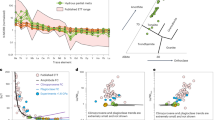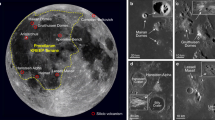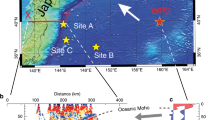Abstract
It is thought that the first continental crust formed by melting of either eclogite or amphibolite, either at subduction zones1 or on the underside of thick oceanic crust2. However, the observed compositions of early crustal rocks and experimental studies have been unable to distinguish between these possibilities3,4,5. Here we show a clear contrast in trace-element ratios of melts derived from amphibolites and those from eclogites. Partial melting of low-magnesium amphibolite can explain the low niobium/tantalum and high zirconium/samarium ratios in melts, as required for the early continental crust, whereas the melting of eclogite cannot. This indicates that the earliest continental crust formed by melting of amphibolites in subduction-zone environments and not by the melting of eclogite or magnesium-rich amphibolites in the lower part of thick oceanic crust. Moreover, the low niobium/tantalum ratio seen in subduction-zone igneous rocks of all ages is evidence that the melting of rutile-eclogite has never been a volumetrically important process.
This is a preview of subscription content, access via your institution
Access options
Subscribe to this journal
Receive 51 print issues and online access
$199.00 per year
only $3.90 per issue
Buy this article
- Purchase on Springer Link
- Instant access to full article PDF
Prices may be subject to local taxes which are calculated during checkout



Similar content being viewed by others
References
Drummond, M. S. & Defant, M. J. A model for trondhjemite-tonalite-dacite genesis and crustal growth via slab melting: Archean to modern comparisons. J. Geophys. Res. 95, 21503–21521 (1990)
Kröner, A. Evolution of the Archean continental crust. Annu. Rev. Earth Planet. Sci. 13, 49–74 (1985)
Martin, H. in Archean Crustal Evolution (ed. Condie, K. C.) 205–259 (Elsevier, Amsterdam, 1994)
Rapp, R. P., Watson, E. B. & Miller, C. F. Partial melting of amphibolite/eclogite and the origin of Archean trondhjemites and tonalites. Precambr. Res. 51, 1–25 (1991)
Wolf, M. B. & Wyllie, P. J. Dehydration-melting of amphibolite at 10 kbar: the effects of temperature and time. Contrib. Mineral. Petrol. 115, 369–383 (1994)
Martin, H. Adakitic magmas: modern analogues of Archean granitoids. Lithos 46, 411–429 (1998)
Karsten, J. L., Klein, E. M. & Sherman, S. B. Subduction zone geochemical characteristics in ocean ridge basalts from the southern Chile ridge: implications of modern ridge subduction systems for the Archean. Lithos 37, 143–161 (1996)
Saunders, A. D., Tarney, J., Kerr, A. C. & Kent, R. W. The formation and fate of large oceanic igneous provinces. Lithos 37, 81–95 (1996)
Arndt, N. T. et al. Were komatiites wet? Geology 26, 739–742 (1998)
Bickle, M. J., Nisbet, E. G. & Martin, A. Archean greenstone belts are not oceanic crust. J. Geol. 102, 121–138 (1994)
Bottazzi, P. et al. Distinct site preferences for heavy and light rare-earth elements and the prediction of Amph/LDREE . Contrib. Mineral. Petrol. 137, 36–45 (1999)
Tiepolo, M. et al. Nb and Ta incorporation and fractionation in titanian pargasite and kaersutite: crystal-chemical constraints and implications for natural systems. Earth Planet. Sci. Lett. 176, 185–201 (2000)
Tiepolo, M., Bottazzi, P., Foley, S. F., Oberti, R. & Zanetti, A. Fractionation of Nb and Ta from Zr and Hf at mantle depths: the role of titanian-pargasite and kaersutite. J. Petrol. 42, 221–232 (2001)
Barth, M. G., Foley, S. F. & Horn, I. Partial melting in Archean subduction zones: constraints from experimentally determined trace-element partition coefficients between eclogitic minerals and tonalitic melts under upper mantle conditions. Precambr. Res. 113, 323–340 (2002)
Foley, S. F., Barth, M. G. & Jenner, G. A. Rutile/melt partition coefficients for trace elements and an assessment of the influence of rutile on the trace element characteristics of subduction zone magmas. Geochim. Cosmochim. Acta 64, 933–938 (2000)
Kennedy, A. K., Lofgren, G. E. & Wasserburg, G. J. An experimental study of trace element partitioning between olivine, orthopyroxene and melt in chondrules: equilibrium values and kinetic effects. Earth Planet. Sci. Lett. 115, 177–195 (1993)
Eggins, S. M., Rudnick, R. L. & McDonough, W. F. The composition of peridotites and their minerals: a laser-ablation ICP-MS study. Earth Planet. Sci. Lett. 154, 53–71 (1998)
Bindemann, I. N., Davis, A. M. & Drake, M. J. Ion microprobe study of plagioclase-basalt partition experiments at natural concentration levels of trace elements. Geochim. Cosmochim. Acta 62, 1175–1193 (1998)
Blundy, J. D. & Wood, B. J. Crystal-chemical controls on the partitioning of Sr and Ba between plagioclase feldspar, silicate melts, and hydrothermal solutions. Geochim. Cosmochim. Acta 55, 193–209 (1991)
Dunn, T. & Sen, C. Mineral/matrix partition coefficients for orthopyroxene, plagioclase, and olivine in basaltic to andesitic systems: a combined analytical and experimental study. Geochim. Cosmochim. Acta 58, 717–733 (1994)
Green, T. H. & Pearson, N. J. An experimental study of Nb and Ta partitioning between Ti-rich minerals and silicate liquids at high pressure and temperature. Geochim. Cosmochim. Acta 51, 55–62 (1987)
Jenner, G. A. et al. Determination of partition coefficients for trace elements in high-pressure-temperature experimental run products by laser ablation microprobe - inductively coupled mass spectrometry (LAM-ICP-MS). Geochim. Cosmochim. Acta 57, 5099–5103 (1993)
Klemme, S., Blundy, J. D. & Wood, B. J. Experimental constraints on major and trace element partitioning during partial melting of eclogite. Geochim. Cosmochim. Acta (in the press)
Jacob, D. E. & Foley, S. F. Evidence for Archean oceanic crust with low high field strength element signature from diamondiferous eclogite xenoliths. Lithos 48, 317–336 (1999)
Rudnick, R. L., Barth, M., Horn, I. & McDonough, W. F. Rutile-bearing refractory eclogites: Missing link between continents and depleted mantle. Science 287, 278–281 (2000)
Stolz, A. J., Jochum, K. P., Spettel, B. & Hofmann, A. W. Fluid- and melt-related enrichment in the subarc mantle: evidence from Nb/Ta variations in island arc basalts. Geology 24, 587–590 (1996)
Panjasawatwong, Y., Danyushevsky, L. V., Crawford, A. J. & Harris, K. L. An experimental study of the effects of melt composition on plagioclase-melt equilibria at 5 and 10 kbar: implications for the origin of magmatic high-An plagioclase. Contrib. Mineral. Petrol. 118, 420–432 (1995)
Ionov, D. A. & Hofmann, A. W. Nb-Ta-rich mantle amphiboles and micas: implications for subduction-related metasomatic trace element fractionations. Earth Planet. Sci. Lett. 131, 341–356 (1995)
Scambelluri, M. et al. Incompatible element-rich fluids released by antigorite breakdown in deeply subducted mantle. Earth Planet. Sci. Lett. 192, 457–470 (2001)
Rollinson, H. R. Petrology and geochemistry of metamorphosed komatiites and basalts from the Sula Mountains greenstone belt Sierra Leone. Contrib. Mineral. Petrol. 134, 86–101 (1999)
Acknowledgements
Discussions with R. Oberti, M.G. Barth and D.E. Jacob helped to shape the findings reported here.
Author information
Authors and Affiliations
Corresponding author
Ethics declarations
Competing interests
The authors declare that they have no competing financial interests.
Rights and permissions
About this article
Cite this article
Foley, S., Tiepolo, M. & Vannucci, R. Growth of early continental crust controlled by melting of amphibolite in subduction zones. Nature 417, 837–840 (2002). https://doi.org/10.1038/nature00799
Received:
Accepted:
Issue Date:
DOI: https://doi.org/10.1038/nature00799
This article is cited by
-
Archaean continental crust formed from mafic cumulates
Nature Communications (2024)
-
Geochemical characterization and zircon U–Pb geochronology of the Tirodi Gneissic Complex, Central Indian Tectonic Zone (CITZ): constraints on petrogenesis, Proterozoic crustal evolution and tectonic setting
Mineralogy and Petrology (2024)
-
Plate tectonics in the Archean: Observations versus interpretations
Science China Earth Sciences (2024)
-
Deep formation of Earth’s earliest continental crust consistent with subduction
Nature Geoscience (2023)
-
I-type and S-type granites in the Earth’s earliest continental crust
Communications Earth & Environment (2023)
Comments
By submitting a comment you agree to abide by our Terms and Community Guidelines. If you find something abusive or that does not comply with our terms or guidelines please flag it as inappropriate.



